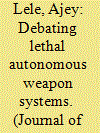|
|
|
Sort Order |
|
|
|
Items / Page
|
|
|
|
|
|
|
| Srl | Item |
| 1 |
ID:
185171


|
|
|
|
|
| Summary/Abstract |
Despite the growing breadth of research related to the perceived risks and benefits of Autonomous Weapon Systems (AWS), there remains a dearth of research into understanding how perceptions of AWS among military officers are affected by design factors. This paper demonstrates that ease of use, and user perception of the concept of using an autonomous weapon system, would be less of a barrier to trusted deployment by this emerging generation of military leaders than ensuring that autonomous systems have robust, transparent and reliable decision-making processes and that operators or supervisors are able to meaningfully monitor the systems nominally under their command. The core contribution of this paper addresses the question of how deliberate design choices could improve or diminish the capacity of junior officers to exercise meaningful human control over autonomous systems.
|
|
|
|
|
|
|
|
|
|
|
|
|
|
|
|
| 2 |
ID:
164001


|
|
|
|
|
| Summary/Abstract |
Technology and the armed forces have a symbiotic relationship. Many technologies which are presently used in day-to-day life, like the Internet or navigation systems (global positioning system [GPS]), actually have a link to, or are derived from, military innovations. Artificial intelligence (AI) is one arena of present generation technology that militaries have been developing mainly for two purposes: first, for juxtaposing it on their existing defence architecture for its performance enhancement; and second, for developing new types of militarily instruments and weapon systems. The research and development to advance new lethal autonomous weapon systems (LAWS) has been bearing good results and a few such systems have already been fully operationalised. It is expected that ongoing advancements in LAWS is likely to establish a different context for their military applicability. This article discusses various aspects of autonomous and lethal autonomous weapon systems.
|
|
|
|
|
|
|
|
|
|
|
|
|
|
|
|
| 3 |
ID:
179509


|
|
|
|
|
| Summary/Abstract |
Small states are often described as weak, and unlikely to achieve their goals when confronted by great powers. However, technologies of the 4th Industrial Revolution, especially autonomous weapon systems combined with artificial intelligence, may enable small states to enhance their security. Therefore, it should be rational for small states to develop strategies based on advances in technology. This article explores three small Scandinavian states – Denmark, Norway, and Sweden – in a comparative perspective of their capability and will to incorporate lethal autonomous weapon systems in their defence forces. Surprisingly, they reflect ambiguous adoption strategies and trajectories.
|
|
|
|
|
|
|
|
|
|
|
|
|
|
|
|
| 4 |
ID:
179962


|
|
|
|
|
| Summary/Abstract |
The emergence of increasingly autonomous uninhabited systems has sparked understandable concern among policymakers, defence personnel, and academics, as well as civil-society. Quite reasonably, the body of literature that is arising in response to this concern has largely remained focused on the ethical, legal and practical consequences of “killer robots” being deployed by great power militaries. Unfortunately, however, this has left significant gaps in our understanding of how the diffusion of uninhabited systems and Artificial Intelligence will impact on security of rising middle powers and the lives of their citizens. This article provides an analysis of how the diffusion of uninhabited systems will influence the exercise of sub-national power, using Southeast Asia as its focal point. In other words, this paper asks the question of how autonomous weapon systems will influence the regimes of power and considers how the blurring of the lines between the law enforcement and military use of force paradigms affects law enforcement, border security, and internal surveillance and repression in this region.
|
|
|
|
|
|
|
|
|
|
|
|
|
|
|
|
|
|
|
|
|